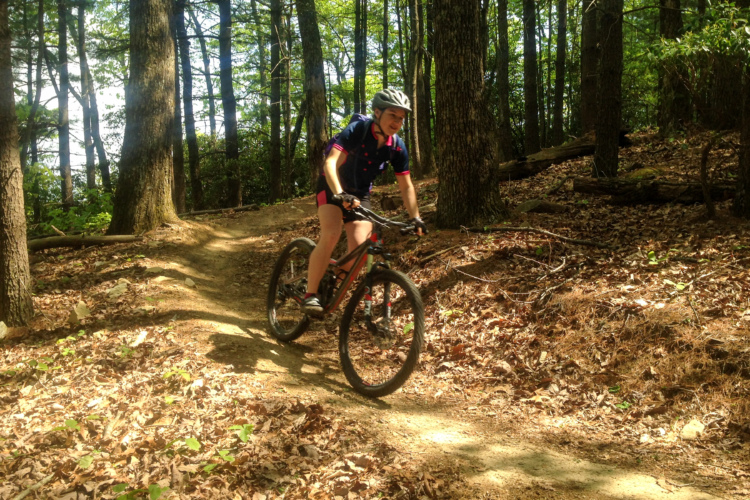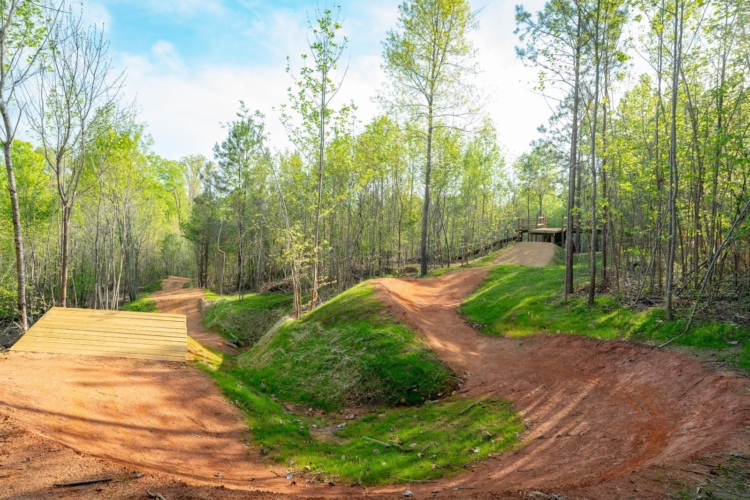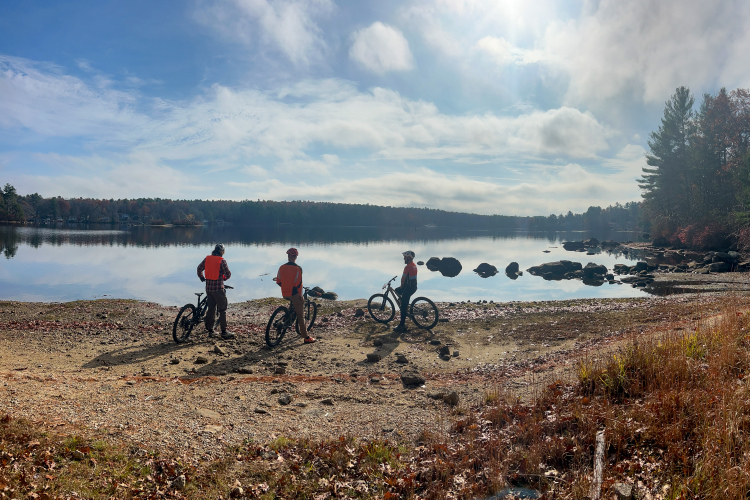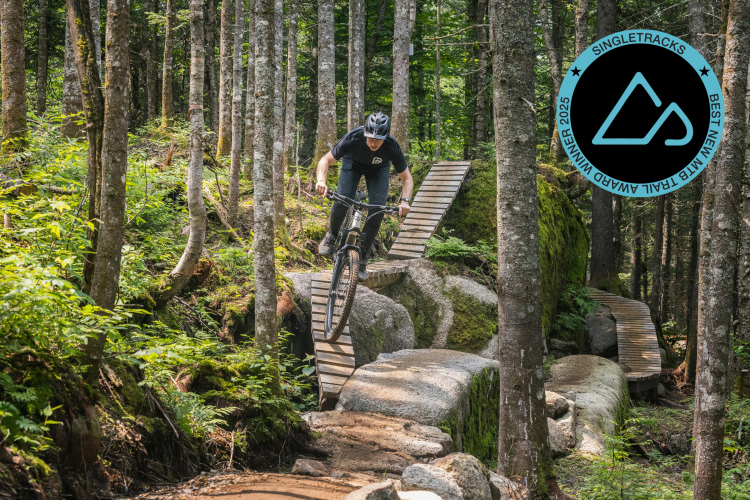
Mountain bikers Asheville, North Carolina, have been anticipating returning to one of the area’s most infamous trails: Greenslick. For several weeks, Greenslick was closed as the trail got a complete top-to-bottom makeover.
Asheville residents and visitors alike will be happy to know that one of their favorite trails is back open — and better than ever.
Bent Creek and Greenslick
The Greenslick trail is located in the Bent Creek area of the Pisgah National Forest. Bent Creek is also the closest and most accessible part of the Pisgah to the Asheville area, resulting in substantial traffic on the area’s trails.
And Greenslick is rated as one of the top trails in Bent Creek.
“[Bent Creek has] tons of well-established parking lots,” Peter Mills told us. “The Greenslick Trail is considered the most advanced trail in this network…so it’s a huge hit.”
Mills is the owner and founder of Elevated Trail Design — the trail crew tasked with the Greenslick rebuild. For Mills, Greenslick was more than just another bid and another project. Mills has roots in the Asheville area and grew up riding Greenslick.
The black diamond-rated Greenslick can be ridden in both directions, although it is primarily a downhill track. Riders drop almost 800ft over the nearly two miles of descending. Greenslick was once an old logging road originally transformed into a trail by Woody Keen and Ed Sutton of Trail Dynamics.
“Back in the day, Woody actually coined a term called ‘Trode,’ a trail-road conversion,” Mills told us. He explained Trail Dynamics’ original work on Greenslick, using what he referred to as walk behind “trail dozers” to carve and transition the forest road into singletrack.
With Greenslick’s growing popularity over the years and weather erosion, the trail Asheville loves so much needed some care.
“Pisgah is one of the — if not the — premier mountain biking locations in the east,” Natalie Narburgh, Executive Director of the Pisgah Area chapter of the Southern Off-Road Bicycle Association (SORBA), told us. “So it’s incredibly well known, and it’s a big challenge to maintain these trails. We have a strong trail infrastructure, and the trails see so much rain.”
Trail erosion is the most significant issue the Pisgah Area SORBA deals with due to the trails being in a rainforest. Narburgh told us that in a previous conversation between Mills and herself, Mills had commented that Greenslick’s features had “melted away.”
Another challenge with the Greenslick rebuild was where the trail is located. Greenslick is in the Bent Creek area, an experimental forest in Pisgah National Forest. Experimental forests are established as field laboratories where the health and longevity of the forest can be studied. The Bent Creek Experimental Forest was established in 1925, making it the oldest experimental forest in the east.
“It is a really special place that has different regulations and different management than the rest of the district,” Narburgh told us. “Even in the new Forest Service plan that was released for the Pisgah/Nantahala National Forest, Bent Creek has its own set of regulations that is taken into account.”

The Greenslick rebuild
Mills felt strongly about the order in which Greenslick was rebuilt. From a trail builder’s perspective, access to the upper sections would be almost non-existent if lower sections were addressed first. What Greenslick needed was a complete rebuild from top to bottom. Mills walked the trail with Pisgah Area SORBA volunteer and Greenslick trail adopter Glenn Middleton.
Both Mills and Narburgh praised Middleton for his dedication to Greenslick. “[Middleton] was very active in trying to maintain the trail, and so he had identified areas that were problematic,” Mills said. “So we had a hit list of drainage issues, seeps, and heavily eroded areas. We examined all that and then proposed how to fix all of those.”
Middleton also was the one to get the ball rolling on the rebuild. He encouraged Narburgh to go after a Recreational Trails Program grant (RTP) to help fund the rebuild. Narburgh applied in the winter of 2023, and the Pisgah Area SORBA received roughly $28,000 from the RTP.
For the Elevated Trail Design crew, working in Bent Creek meant staying within the established Greenslick corridor. Jumping outside the corridor would trigger the NEPA process, likely extending the project from weeks to years. Mills had to work with what was already there.
“You can’t disturb outside of the logging roads. We weren’t taking trees down. We were not importing dirt or importing rock,” Mills explained. This was made even more challenging by the handful of straights on Greenslick, where riders generate high amounts of speed. “The challenge is how do we slow people down and retain the rugged qualities of the trail.”
Fortunately, working on an old logging road meant a wider corridor, and Elevated Trail Design could get a small excavator into these troublesome areas. Mills worked with the rock within the corridor to help riders control their speed while keeping the trail technical. He explained that they use the bigger machines to help shape the trail and move the heavier rocks. Hand crews follow the machines, doing more of the fine work and creating a singletrack experience, making riders forget about the logging road beneath them.
In addition to the rocky and rooty terrain, Mills told us that the soil has a relatively high clay content. While this is great for shaping and creating the singletrack, it can be problematic regarding erosion.
“It’s challenging in that clay can hold a shape,” Mills said, “but the negatives are that it traps moisture and can freeze and thaw pretty significantly.”



While ensuring that Greenslick would remain a challenging trail, Elevated Trail Designs also set a goal of creating a sustainable trail. Knowing that locals would be riding in the rain and even the snow, Elevated Trail Designs had to focus on adequately draining Greenslick. Mills told us this meant going above and beyond in terms of how they shed water.
In some areas, the existing water drainage was apparent, and the trail crew could take advantage of what was there. In other places, the existing drainage either did not work or wouldn’t work with the new design. Regardless, more drainage for Greenslick was the goal, which Mills said may not have been possible without using the excavator.
Elevated Trail Designs made quick work of the two-mile rebuild. Their bid was submitted in January of this year, with trail work starting on July 8th. With the rebuild wrapped up, tires were back on the Greenslick on August 16th.
Mountain bikers who love their trails are often wary of change and can be quick to express their disapproval. With Mills living less than 30 minutes from Greenslick, taking on the rebuild was not only personal but a bit stressful.
“We put everything we had in it to try to make the most hardcore, old school, Asheville-bike bro [say], ‘oh, this is actually a rugged trail,’” Mills told us. “It was a challenge. I know some folks didn’t want to bid because of that. But I think we kind of surprised some folks. I mean, I’ve been getting a lot of positive feedback.”











5 Comments
Aug 31, 2024
Aug 30, 2024
Aug 30, 2024
Sep 6, 2024
Aug 30, 2024